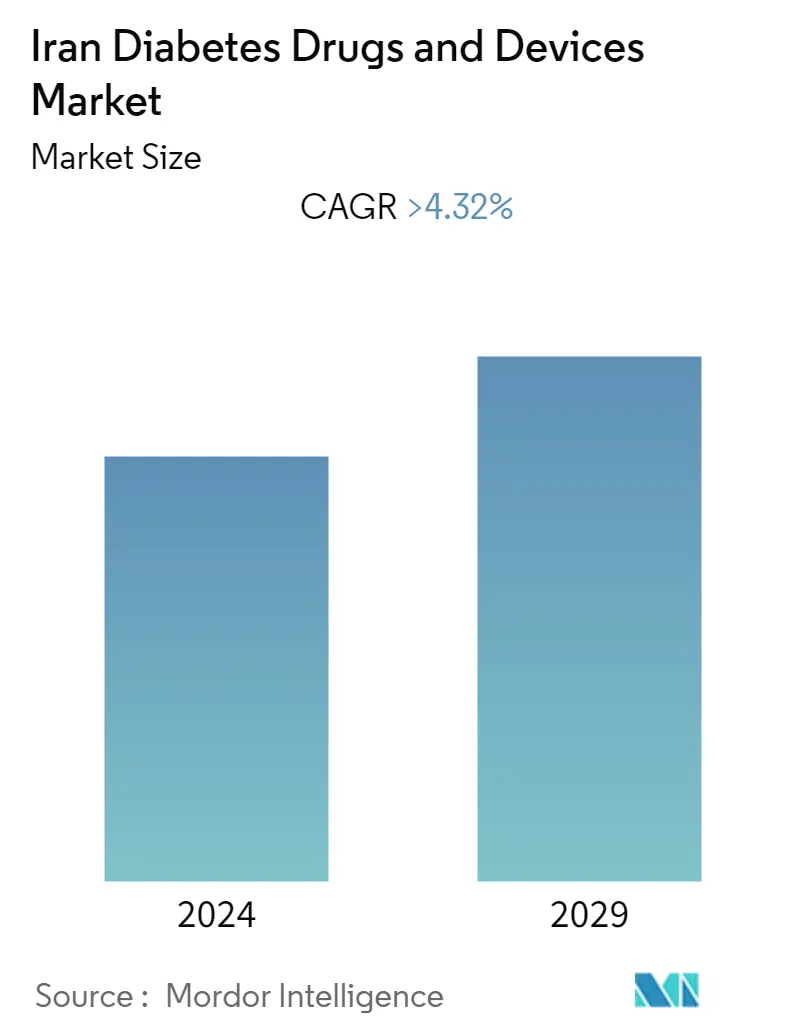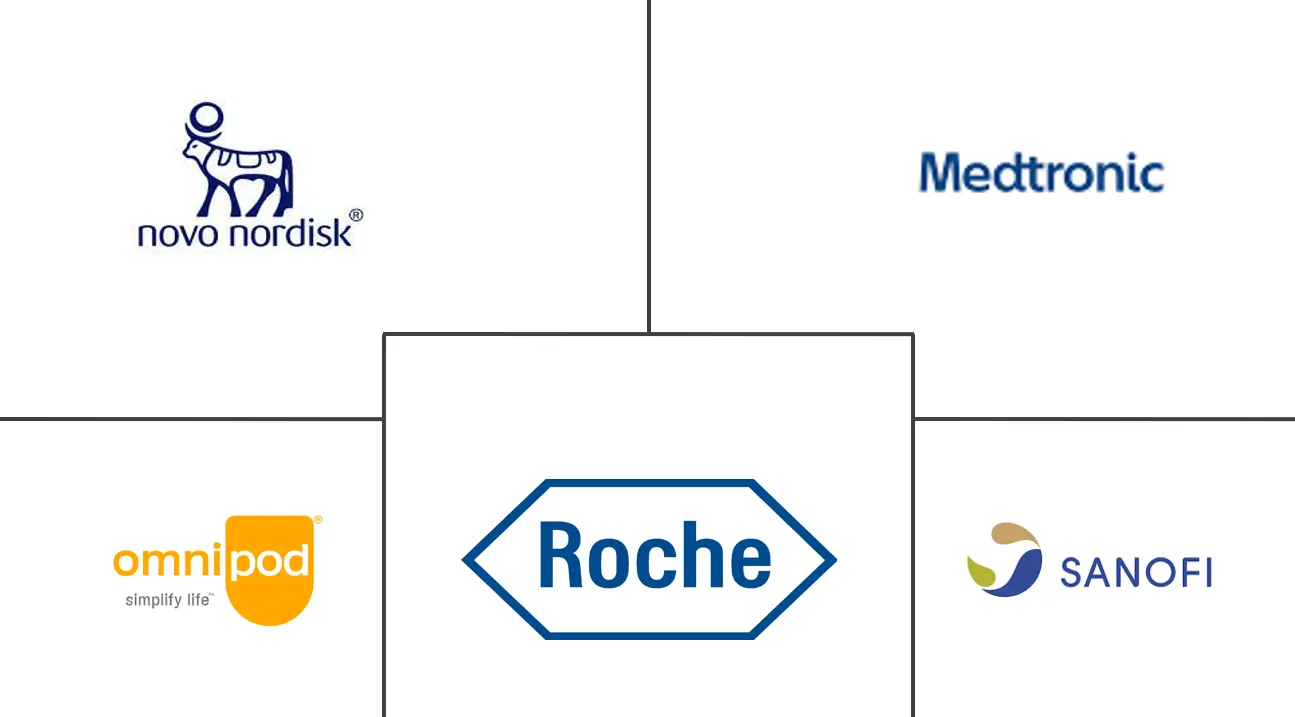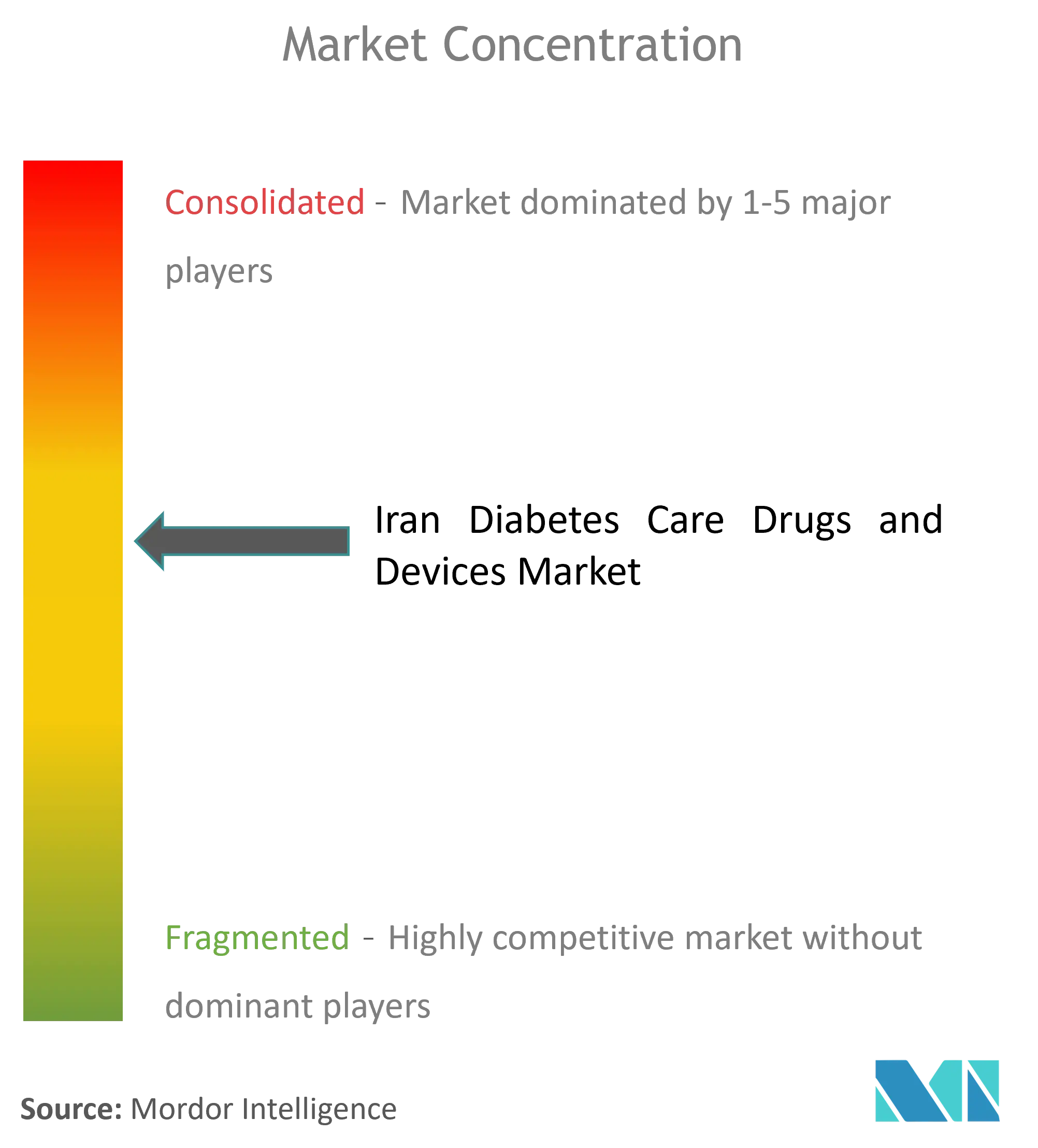Iran Diabetes Drugs and Devices Market Size

| Study Period | 2018 - 2029 |
| Base Year For Estimation | 2023 |
| Forecast Data Period | 2024 - 2029 |
| Historical Data Period | 2018 - 2022 |
| CAGR | 4.32 % |
Major Players
*Disclaimer: Major Players sorted in no particular order |
Iran Diabetes Drugs and Devices Market Analysis
Iran's diabetes drugs and devices market size is estimated at USD 1 billion in the current year. The market is expected to reach 1.3 billion in five years, registering a CAGR of more than 4.3% during the forecast period.
Inadequate precautions that disrupt traditional patient relationships, drug shortages, disruptions to routine diabetes care, and the lack of infrastructure for telemedicine services increase the risk to developing countries during the COVID-19 pandemic. This presents the most significant challenge in diabetes care management. Diabetes is becoming increasingly common in Iran, as in many other countries. In addition to the difficulties posed by diabetes management in a poor country, Iran has faced new challenges over the past two years due to increased sanctions. During the COVID-19 crisis, the severity of sanctions in Iran more than tripled. Regular blood glucose monitoring, healthy diet, regular physical activity, medication, and adherence to foot care should be considered to control hyperglycemia better and prevent or at least delay complications in people with diabetes. This is an essential component of diabetes self-management. During the COVID-19 crisis, shortages and rising prices of devices such as insulin pens increased patient anxiety and hindered disease management.
One of the most common problems faced by patients is poor medication adherence. Many patients find it challenging to follow recommended treatments. Adherence rates for oral hypoglycemic agents (OHAs) range from 36% to 93% in managing type 1 and type 2 diabetes. Sulfonylureas are commonly used to treat type 2 diabetes. Patient compliance is critical to the effectiveness of oral diabetes therapy. It was crucial to highlight the current state of compliance with diabetes medications among patients with type 2 diabetes in Tehran and the cultural differences within the same Iranian community.
Based on the abovementioned period, the market under study is expected to grow during the analysis period.
Iran Diabetes Drugs and Devices Market Trends
The continuous Glucose Monitoring Segment is Expected to Witness the Highest Growth Rate Over the Forecast Period
Continuous glucose monitoring sensors use glucose oxidase to measure blood sugar levels. Glucose oxidase converts glucose to hydrogen peroxidase, which reacts with platinum in the sensor to send an electrical signal to a transmitter. The sensor is the most important part of any continuous blood glucose monitoring device. Technological advances in improving sensor accuracy are expected to drive the growth of the segment during the forecast period.
According to a research study conducted by Joost van der Linden et al. and published in the Diabetes Technology & Therapeutics Journal, real-time continuous glucose monitoring (rtCGM) was employed at a population level to analyze changes in glycemic control with diversified temporal and geographic precision. Furthermore, current continuous glucose monitoring devices can provide a retrospective view of blood glucose levels by downloading the data or giving an up-to-date overview via a receiver display. As newer technologies like cell phone integration become more accessible and cost-effective, this segment is likely to experience growth in the foreseeable future.
The industry players are adopting diverse techniques such as collaborations, partnerships, mergers, acquisitions, and expansions to boost industry disclosure. For instance, WaveForm Technologies Inc., developer of innovative cosmetics for continual glucose monitoring, and A. Menarini Diagnostics S. r. l. guiding diagnostics company, entered a partnership to commercialize WaveForm Technologies' continual Glucose supervise (CGM). Thus, owing to the influences mentioned above, it's expected to control the slice development over the forecast period.

Rising diabetes prevalence
Patients with type 1 diabetes (T1D) must maintain a good lifestyle, influenced by individual personality traits, social interactions, socioeconomic status, and living environment variables. Continuous glucose monitoring (CGM) combined with multiple daily injections (MDI) has been shown to reduce non-severe and severe hypoglycemia in patients with type 1 diabetes who are prone to this side effect. Patients with type 1 diabetes, who are at high risk of hypoglycemia, can use self-contained continuous blood glucose monitoring to control their blood sugar levels, even in the dire living conditions created by the severe lockdowns caused by the COVID-19 pandemic crisis. You can control it. People with diabetes in Iran face economic hardships. Pharmacies do not sell enough insulin for diabetics. Instead, more expensive insulin will be sold on the open market. Parents of diabetic children may not be able to find insulin. For children and adults with type 1 diabetes, insulin costs 20-30% of their monthly family income. This does not include the cost of costly test strips and other consumables. In addition, Iranian insurers are cutting funding for diabetes treatment. Limited insulin is available, and Iranian families with diabetic children are coping by reducing the amount of carbohydrates in their children's diets. People living with Diabetes in Iran confront financial difficulties.
Pharmacies do not sell enough insulin to people with diabetes; instead, insulin is sold on the open market at a higher price. Sometimes, a diabetic child's parent is unable to locate insulin. Insulin costs 20-30% of a family's monthly income for type 1 diabetic children and adults. This does not include the excessively high cost of test strips and other supplies. In addition, insurance firms in Iran are lowering financial assistance for diabetes treatments. Because insulin is scarce, Iranian families with diabetes children adapt by limiting the number of carbs in their children's diet. Though food and lifestyle are highly helpful in managing blood glucose levels, they frequently fail and necessitate oral medication therapy. If the second phase of pharmacological therapy fails, multiple oral medicines will be used. Various therapies will be optimized, and they will be shifted to oral-injectable multiple treatments in the ultimate stages. Guidelines for regulating blood glucose levels have evolved with broad modifications in hyperglycaemia prescription therapy. Considering these developments in diabetes care, the trend in glucose-lowering medicines and their efficacy in blood glucose is critical.
The increasing diabetes prevalence and the above factors will likely drive segment growth over the forecast period.

Iran Diabetes Drugs and Devices Industry Overview
Manufacturers have constantly innovated to survive in the market. Large companies such as Abbott and Medtronic have made numerous mergers, acquisitions, and partnerships to gain market dominance while adhering to organic growth strategies. The manufacturers of insulin delivery devices are spending a huge amount on the R&D of the devices. For example, Novo Nordisk partnered with Abbott Diabetes Care, which may also assist in enabling insulin statistics to be shared between Novo Nordisk-connected insulin pens and digital fitness equipment well suited to the FreeStyle Libre portfolio of products.
Iran Diabetes Drugs and Devices Market Leaders
-
Medtronics
-
Roche
-
NovoNordisk
-
Sanofi
-
Omnipod
*Disclaimer: Major Players sorted in no particular order

Iran Diabetes Drugs and Devices Market News
- August 2022: Tirzepatide, A weight-loss drug, is now available in UAE to treat Type 2 diabetes. Mounjaro, or Tirzepatide, is a US Food and Drug Administration-approved injectable prescription medication used to improve blood sugar, or glucose, through weight loss.
- February 2022: Abbott said it has tied up with various health-tech firms like BeatO Sugar.fit, PharmEasy, GOQii, 1MG, and Zyla for diabetes care. The company said it has also joined hands with Health, HealthifyMe, and Fitterfly under the initiative.
Table of Contents
1. INTRODUCTION
- 1.1 Study Assumptions and Market Definition
- 1.2 Scope of the Study
2. RESEARCH METHODOLOGY
3. EXECUTIVE SUMMARY
4. MARKET DYNAMICS
- 4.1 Market Overview
-
4.2 Market Dynamics
- 4.2.1 Market Drivers
- 4.2.2 Market Restraints
-
4.3 Porter's Five Forces Analysis
- 4.3.1 Bargaining Power of Suppliers
- 4.3.2 Bargaining Power of Consumers
- 4.3.3 Threat of New Entrants
- 4.3.4 Threat of Substitute Products and Services
- 4.3.5 Intensity of Competitive Rivalry
5. Market Segmentation (Market Size by Value - USD)
-
5.1 Devices
- 5.1.1 Monitoring Devices
- 5.1.1.1 Self-monitoring Blood Glucose Devices
- 5.1.1.2 Continuous Blood Glucose Monitoring
- 5.1.2 Management Devices
- 5.1.2.1 Insulin Pump
- 5.1.2.2 Insulin Syringes
- 5.1.2.3 Insulin Cartridges
- 5.1.2.4 Disposable Pens
-
5.2 Drugs
- 5.2.1 Oral Anti-Diabetes Drugs
- 5.2.2 Insulin Drugs
- 5.2.3 Combination Drugs
- 5.2.4 Non-Insulin Injectable Drugs
6. Market Indicators
- 6.1 Type-1 Diabetes Population
- 6.2 Type-2 Diabetes Population
7. COMPETITIVE LANDSCAPE
-
7.1 Company Profiles
- 7.1.1 Novo Nordisk
- 7.1.2 Medtronic
- 7.1.3 Insulet
- 7.1.4 Tandem
- 7.1.5 Ypsomed
- 7.1.6 Novartis
- 7.1.7 Sanofi
- 7.1.8 Eli Lilly
- 7.1.9 Abbottt
- 7.1.10 Roche
- 7.1.11 Astrazeneca
- 7.1.12 Dexcom
- 7.1.13 Pfizer
- *List Not Exhaustive
- 7.2 Company Share Analysis
8. MARKET OPPORTUNITIES AND FUTURE TRENDS
** Subject To AvailablityIran Diabetes Drugs and Devices Industry Segmentation
Patients with type 1 diabetes must be given insulin because their pancreas cannot process it. To control blood sugar levels, insulin must be offered several times daily, such as when eating or drinking. Many people with type 2 diabetes also need to take antidiabetic drugs. These drugs include diabetes medications and injections such as insulin. Russia's diabetes drugs and devices market is segmented by drugs (insulin, oral anti-diabetic drugs, non-insulin injectable drugs, and combination drugs) and devices (management devices (insulin pumps, insulin pens, syringes, cartridges, and jet injectors) and monitoring devices (self-monitoring blood and continuous glucose monitoring)). The report offers the value (in USD) and volume (in unit) for the above segments.
| Devices | Monitoring Devices | Self-monitoring Blood Glucose Devices |
| Continuous Blood Glucose Monitoring | ||
| Devices | Management Devices | Insulin Pump |
| Insulin Syringes | ||
| Insulin Cartridges | ||
| Disposable Pens | ||
| Drugs | Oral Anti-Diabetes Drugs | |
| Insulin Drugs | ||
| Combination Drugs | ||
| Non-Insulin Injectable Drugs |
Frequently Asked Questions
What is the current Iran Diabetes Drugs and Devices Market size?
The Iran Diabetes Drugs and Devices Market is projected to register a CAGR of greater than 4.32% during the forecast period (2024-2029)
Who are the key players in Iran Diabetes Drugs and Devices Market?
Medtronics, Roche, NovoNordisk, Sanofi and Omnipod are the major companies operating in the Iran Diabetes Drugs and Devices Market.
What years does this Iran Diabetes Drugs and Devices Market cover?
The report covers the Iran Diabetes Drugs and Devices Market historical market size for years: 2018, 2019, 2020, 2021, 2022 and 2023. The report also forecasts the Iran Diabetes Drugs and Devices Market size for years: 2024, 2025, 2026, 2027, 2028 and 2029.
Iran Diabetes Drugs and Devices Industry Report
Statistics for the 2024 Iran Diabetes Drugs and Devices market share, size and revenue growth rate, created by Mordor Intelligence™ Industry Reports. Iran Diabetes Drugs and Devices analysis includes a market forecast outlook to for 2024 to 2029 and historical overview. Get a sample of this industry analysis as a free report PDF download.



